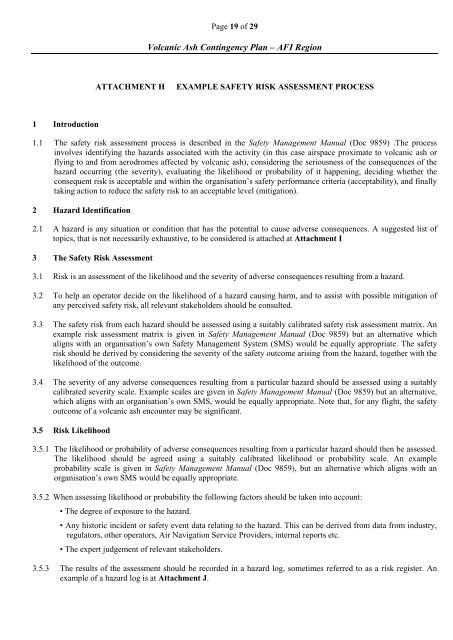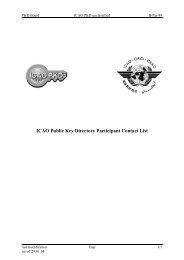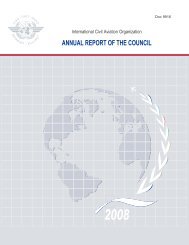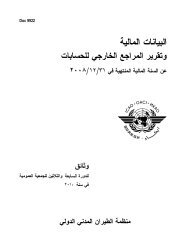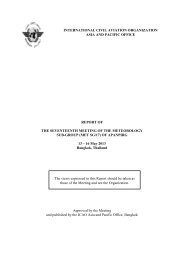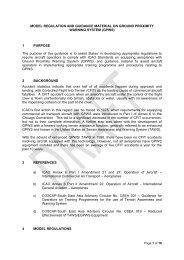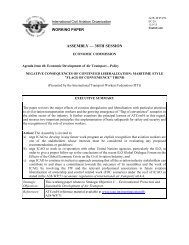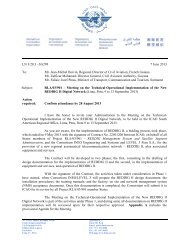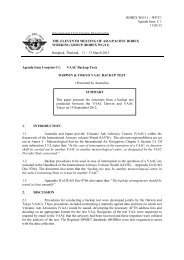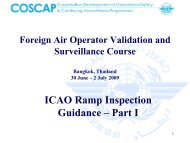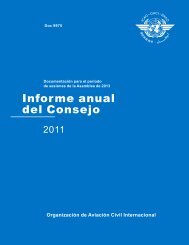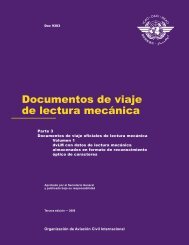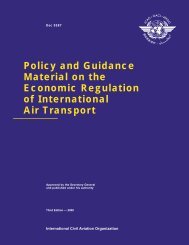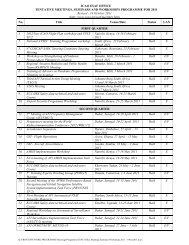afi met bulletins exchange (ambex) handbook - ICAO
afi met bulletins exchange (ambex) handbook - ICAO
afi met bulletins exchange (ambex) handbook - ICAO
Create successful ePaper yourself
Turn your PDF publications into a flip-book with our unique Google optimized e-Paper software.
1 Introduction<br />
Page 19 of 29<br />
Volcanic Ash Contingency Plan – AFI Region<br />
ATTACHMENT H EXAMPLE SAFETY RISK ASSESSMENT PROCESS<br />
1.1 The safety risk assessment process is described in the Safety Management Manual (Doc 9859) .The process<br />
involves identifying the hazards associated with the activity (in this case airspace proximate to volcanic ash or<br />
flying to and from aerodromes affected by volcanic ash), considering the seriousness of the consequences of the<br />
hazard occurring (the severity), evaluating the likelihood or probability of it happening, deciding whether the<br />
consequent risk is acceptable and within the organisation’s safety performance criteria (acceptability), and finally<br />
taking action to reduce the safety risk to an acceptable level (mitigation).<br />
2 Hazard Identification<br />
2.1 A hazard is any situation or condition that has the potential to cause adverse consequences. A suggested list of<br />
topics, that is not necessarily exhaustive, to be considered is attached at Attachment I<br />
3 The Safety Risk Assessment<br />
3.1 Risk is an assessment of the likelihood and the severity of adverse consequences resulting from a hazard.<br />
3.2 To help an operator decide on the likelihood of a hazard causing harm, and to assist with possible mitigation of<br />
any perceived safety risk, all relevant stakeholders should be consulted.<br />
3.3 The safety risk from each hazard should be assessed using a suitably calibrated safety risk assessment matrix. An<br />
example risk assessment matrix is given in Safety Management Manual (Doc 9859) but an alternative which<br />
aligns with an organisation’s own Safety Management System (SMS) would be equally appropriate. The safety<br />
risk should be derived by considering the severity of the safety outcome arising from the hazard, together with the<br />
likelihood of the outcome.<br />
3.4 The severity of any adverse consequences resulting from a particular hazard should be assessed using a suitably<br />
calibrated severity scale. Example scales are given in Safety Management Manual (Doc 9859) but an alternative,<br />
which aligns with an organisation’s own SMS, would be equally appropriate. Note that, for any flight, the safety<br />
outcome of a volcanic ash encounter may be significant.<br />
3.5 Risk Likelihood<br />
3.5.1 The likelihood or probability of adverse consequences resulting from a particular hazard should then be assessed.<br />
The likelihood should be agreed using a suitably calibrated likelihood or probability scale. An example<br />
probability scale is given in Safety Management Manual (Doc 9859), but an alternative which aligns with an<br />
organisation’s own SMS would be equally appropriate.<br />
3.5.2 When assessing likelihood or probability the following factors should be taken into account:<br />
• The degree of exposure to the hazard.<br />
• Any historic incident or safety event data relating to the hazard. This can be derived from data from industry,<br />
regulators, other operators, Air Navigation Service Providers, internal reports etc.<br />
• The expert judgement of relevant stakeholders.<br />
3.5.3 The results of the assessment should be recorded in a hazard log, so<strong>met</strong>imes referred to as a risk register. An<br />
example of a hazard log is at Attachment J.


